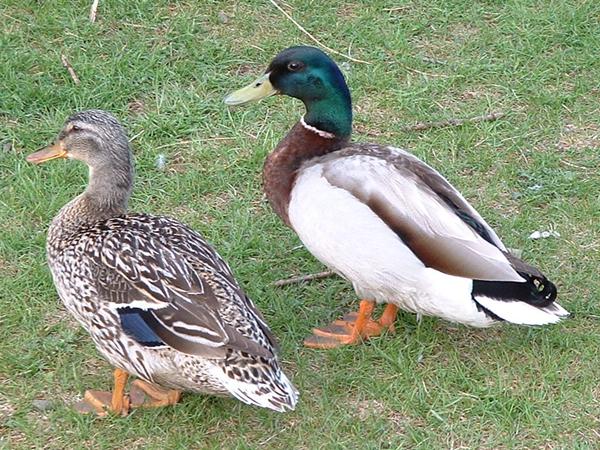
Mallard, or Wild duck(Anas platyrhynchos)
Phylum —chordata
Class — aves
Order — anseriformes
Family — anatidae
Genus –anas
Appearance
The mallard is undoubtably the most recognized waterfowl in the world. The familiar duck morphology is complemented with a iridesent blue speculum on the wings in both sexes. On the male, the notable characteristics are the green iridesent plumage on the head and neck, and curled black feathers on the tail. The female's plumage is drab brown.
The mallard is a medium-sized waterfowl species that is often slightly heavier than most other dabbling ducks. It is 50–65 cm (20–26 in) long – of which the body makes up around two-thirds – has a wingspan of 81–98 cm (32–39 in), and weighs 0.72–1.58 kg (1.6–3.5 lb).
Habitat
Mallards can be found almost anywhere in the world. They dominate the Northern Hemisphere, and can be found easily in Oceana, Asia, Africa, South America and many islands.
Behavior
After the breeding season, mallards form flocks and migrate from northern latitudes to warmer southern areas. There they wait and feed until the breeding season starts again. Some mallards, however, may choose to stay through the winter in areas where food and shelter are abundant; these mallards make up a resident population.
Diet
Mallards consume a wide variety of foods, including vegetation, insects, worms, gastropods and arthropods, although they are not restricted to these. They also take advantage of human food sources, such as gleaning grain from crops.
Reproduction
Mallards usually form pairs (in October and November in the Northern Hemisphere) until the female lays eggs at the start of the nesting season, which is around the beginning of spring. At this time, she is left by the male who joins up with other males to await the moulting period, which begins in June (in the Northern Hemisphere). During the brief time before this, however, the males are still sexually potent and some of them either remain on standby to sire replacement clutches (for female mallards that have lost or abandoned their previous clutch) or forcibly mate with females that appear to be isolated or unattached regardless of their species and whether or not they have a brood of ducklings.
The hen usually lays 9-13 eggs in a nest on the ground near a body of water.
The eggs are laid on alternate days, and incubation begins when the clutch is almost complete. Incubation takes 27–28 days and fledging takes 50–60 days. The ducklings are precocial and fully capable of swimming as soon as they hatch. However, filial imprinting compels them to instinctively stay near the mother, not only for warmth and protection but also to learn about and remember their habitat as well as how and where to forage for food. When ducklings mature into flight-capable juveniles, they learn about and remember their traditional migratory routes (unless they are born and raised in captivity).
During the breeding season, both male and female mallards can become aggressive, driving off competitors to themselves or their mate by charging at them.
In captivity
Lifespan in captivity is up to 25 years.
In the cold season, birds are kept in sections of the poultry house. Access to paddocks is open only on warm, windless, sunny days and only during the daytime.
Wild ducks become restless in the fall, when they fly south seasonally, and may join other wild ducks and fly away with them, so you should trim their wings in time or restrict access to walking. You can also cover the paddock with a net.
For winter keeping of ducks any shed (paddock) in which they are protected from wind and precipitation is suitable. The pen for ducks is built in such a way that one duck has at least 1 sq. m. of area with a room of the height of 70-100 cm. Ducks are not afraid of the cold; if they are full, clean and healthy, they can easily live at any frost.
The area of the paddock should not be less than the area of the paddock shed itself.
One duck needs a range of 4 sq. m.In this case, all winter it is necessary to maintain a sufficient mirror of the reservoir for birds, not covered with ice. This is achieved in various ways, one of which may be the use of an air compressor. Long hoses from the compressor that pumps air are lowered to the bottom of the reservoir, and air bubbles, rising up, carry warmer water. With constant mixing of warm water from the lower layers of the reservoir with colder water from the surface, the possibility of ice formation is eliminated even in the most severe frosts.
As a winter bedding for waterfowl, you can use soft hay, which is laid out in places where birds rest.
The diet includes grain feed-corn, wheat, barley, millet, oatmeal, wheat bran, grass, meat and fish meal, chalk, small shell, gammarus. In the warm season, it is good to give various greens - cut dandelion leaves, lettuce, plantain, duckweed. Good food for ducks - wet mixture of grated carrots, bran, various cereals.
Mallardsare friendly to other birds, so they can be kept on the same pond with other ducks.
Artificial shelters for nests are installed in the paddock. Ducks independently incubate, breed and raise ducklings.
 Russian
Russian
 English
English
























